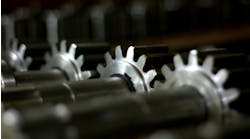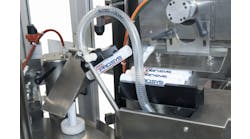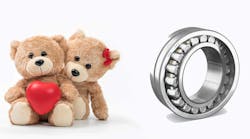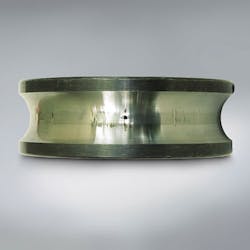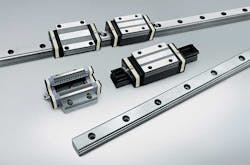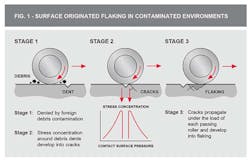Caring for Bearings: Essential Maintenance Tips To Keep Your Plant Rolling
When most people consider ball bearings, they envision robust and rugged machine parts that can take all kinds of knocking about, vibrations, high temperatures, and friction. But the reverse is true. Bearing reliability depends on many different factors such as loading, speed, fitting, setting, operating temperature, and being kept in pristine conditions. Handling with extreme care along with lubrication and maintenance to avoid contamination and other environmental factors is also essential.
Since rolling bearings are high-precision machine parts, they must be handled while taking the following main precautions into account:
Keep Bearings and Surroundings Clean
Dust and dirt—even if not visible—have harmful effects on bearings. Keep bearing handling rooms as clean as possible, and do not remove bearings from their packaging until just before use.
Handle With Care
Heavy shocks during handling may scratch or cause other damage to the bearing, possibly resulting in premature bearing failure. Strong impacts can result in brinelling, breaking, or cracking (see troubleshooting below). Never use a bearing that has been dropped, as it may be dented and can cause a high level of acoustic noise.
Always Use Proper the Tools
When handling bearings; avoid general-purpose tools. When applying lubricant, never use an applicator that can leave contaminants behind, like a cotton swab which can leave fibrous particles.
Protect Bearings From Corrosion
This is the cause of 95% of bearing failures, so if this sounds like a broken record when it comes to corrosion, this is why. Even perspiration on the hands as well as various other contaminants can cause corrosion which is why wearing gloves is advisable when handling bearings.
Key Bearing Performance Factors
It’s necessary to periodically inspect and maintain the bearing under its operating conditions, to maximize the bearing life. To determine the bearing replacement period and the replenishment intervals for lubricants, there are a few telltale factors to monitor:
Bearing Noise
During operation, a sound detection instrument, like a stethoscope or a proprietary instrument, can be used to investigate the volume and characteristics of bearing rotation noise. It is possible to distinguish and diagnose bearing damage by its sound.
Bearing vibration
Irregularities can be analyzed by measuring the vibrations of an operating machine. A frequency spectrum analyzer can measure the magnitude of the vibration and the distribution of the frequencies. Test results can determine the likely cause of the bearing irregularity.
Bearing Temperature
This can be measured from the housing outside surface, but a better way to do it is to obtain a direct reading from the bearing outer ring by a probe going through an oil hole. Because the temperature tends to increase with operation, wait one to two hours after the start of an operation to monitor the temperature.
Effects of Lubrication
The main purposes of lubrication are to minimize friction and reduce wear inside bearings. It does this by dissipating frictional heat and cooling, and by sealing the unit to prevent rust from forming. Bearing lubrication methods fall into two categories: grease and oil lubrication. Each has its advantages in certain application conditions and proper selection of the method will impact performance.
Lubrication whether oil or grease, will deteriorate over time, and periodic replenishment is required. The replacement intervals depend on the operating conditions (i.e. temperature), type of grease used, the magnitude of the bearing load, and the oil quantity.
Troubleshooting Linear Motion Components
While radial bearings must be maintained properly for a longer life, when bearings are used in linear motion components there are specific issues to watch out for.
In general, if rolling bearings are used correctly they will survive to their predicted fatigue life. Bearings can fail prematurely, however, due to avoidable mistakes. This is caused by improper mounting, mishandling, poor lubrication, contamination or abnormal heat generation when operating.
If the nature of the failure can be determined, a countermeasure can be taken to reduce similar failures or prevent them from happening again. Here is a troubleshooting guide to the most common issues:
Flaking
When linear guides approach or reach their rolling fatigue life, scaly particles flake away from the surface of the raceways and balls. There are a few reasons this is happening.
It could be the natural life of a linear guide; improper assembly or misalignment; poor flatness of the mounting surface; insufficient or improper lubricant; or intrusion of foreign matter or water. If flaking is noticed, there are a few steps to repair the issue.
Improving the flatness of the mounting surface or the accuracy of the assembly could offer a solution. If lubrication is the culprit, try switching to a better method or try a more suitable lubricant to see if that resolves the issue. If there is contamination of any kind, review the protective covers and/or enhance the sealing capability of the linear guide.
Wear and Tear
Wear and tear on the rolling contact surface or the balls can result from severe friction, and this is generally a result of insufficient lubrication, improper installation or an intrusion of foreign matter. If misalignment isn’t a factor, checking the sealing capability and the lubricant is the best option.
Fretting Corrosion
A specific type of wear that results from repeated rubbing between contacting surfaces. It is almost certainly caused by completely dried-out lubricant on the contacting area because of minute amplitude oscillation.
Use anti-fretting grease and distribute the lubricant over the contact surfaces by longer stroke motions at a certain frequency (i.e.: once every 5,000 cycles).
Indentations
Occur on the raceway at each ball location like the deformation caused by a Brinell Hardness Test. High energy impacts or improper handling of the product at its installation or in transit will easily cause this sort of damage. General dents on the raceway could also be caused by contamination or intruded metallic particles. If this is suspected, improved sealing and filtering of lubrication oil is advisable.
Electrolytic Corrosion
Presents in pit-like spot corrosion on balls and raceways. Caused by an electric current, creating sparks through a thin oil film, between the contact points of the raceways and balls while a linear guide was in operation (electric potential difference between a rail and a ball slide).
An effective countermeasure would be to provide an electric circuit so that the current doesn’t pass through the linear guides.
Corrosion
Can be noticed on raceways and balls. This could be a result of water or corrosive substance intrusion, inadequate lubrication or improper storage. Review the sealing function and the lubrication system, as well as the storing condition. It might make sense to cage to a higher anti-acid material or better surface treatment.
Damaged Ball Recirculation
Occurs when balls become free from the ball slide due to broken plastic ball re-circulation parts. This could be caused by abnormal wear caused by lubrication failure and intruded particles. If this is the case, review the lubrication system, and improve the sealing function.
In the case of butting rail specification, a ball re-circulation part collided with the rail at the rail butting position because of excessive misalignment of rails in lateral and vertical directions. This can be resolved by improving the butting accuracy (lateral and vertical aligning accuracy at butting position).
Another cause could be the feed speed rate exceeding the permissible speed in which case reviewing the feed and looking at adding a high-speed end cap on the linear guide.
